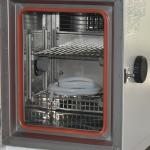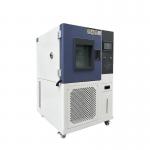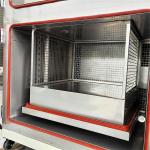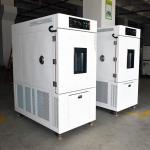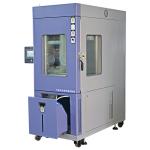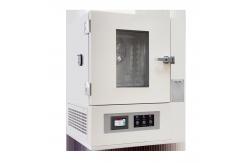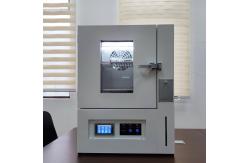In the modern era of scientific research, product development, and
quality control, the need for accurate and reliable environmental
testing has become more crucial than ever. The Customized
Programmable Desktop Benchtop Constant Temperature and Humidity
Test Chamber is a state-of-the-art solution that offers
unparalleled precision and flexibility in a compact and convenient
form factor. This highly specialized test chamber is designed to create and
maintain a precisely controlled environment of constant temperature
and humidity within a desktop or benchtop setting. The
customization aspect allows it to be tailored to meet the specific
requirements of a wide range of industries and applications. It
serves as an essential tool for researchers, engineers, and quality
assurance professionals who need to evaluate the performance and
durability of various materials, components, and products under
specific environmental conditions. Whether it's testing the
stability of pharmaceuticals, the reliability of electronic
components, or the quality of food and cosmetic products, this
chamber provides a controlled microcosm that mimics real-world
scenarios with remarkable accuracy. - Compact and Sturdy Design
- The chamber is constructed with a durable and space-efficient
design, making it ideal for laboratory benchtops or desktop use.
The exterior is typically made of high-quality, corrosion-resistant
materials such as stainless steel or rigid plastic composites,
ensuring long-term durability and resistance to wear and tear. The
interior is lined with a non-reactive and smooth surface to prevent
any interaction between the chamber and the tested samples. Despite
its compact size, the chamber is engineered to provide excellent
insulation, minimizing heat and moisture transfer to the outside
environment and maintaining stable internal conditions.
- The door of the chamber is designed for easy access and a reliable
seal. It features a secure locking mechanism and a gasket that
ensures an airtight and watertight enclosure. The door is also
equipped with a clear viewing window, usually made of tempered
glass, which allows for visual monitoring of the testing process
without disturbing the internal environment. The window may have
anti-fog properties to maintain clear visibility even during
periods of high humidity.
- Precision Temperature and Humidity Control Systems
- Temperature Control: The temperature control system is highly
accurate and can maintain a wide temperature range, typically from
-20°C to +80°C, with an impressive accuracy of ±0.1°C. It utilizes
advanced heating and refrigeration technologies, along with a
sophisticated feedback loop and multiple temperature sensors
strategically placed within the chamber. This ensures uniform
temperature distribution and rapid temperature change capabilities,
allowing for efficient thermal cycling experiments and precise
temperature stability for long-term testing.
- Humidity Control: The humidity control system is equally precise,
capable of adjusting the relative humidity from 10% to 95% RH, with
an accuracy of ±2% RH. The chamber is equipped with a
high-efficiency humidifier and dehumidifier, which work in harmony
to achieve rapid and accurate humidity adjustments. Special care is
taken to prevent condensation, which could affect the test results
and damage the samples. The system also features a dew point
control function, which is crucial for maintaining the integrity of
the internal climate and ensuring accurate and repeatable testing.
- Programmability: One of the key features of this test chamber is
its programmable control panel. It allows users to create and store
complex temperature and humidity profiles, enabling the simulation
of a wide variety of environmental conditions. For example, users
can program cyclic temperature and humidity changes to replicate
daily or seasonal variations, or they can set specific stepwise
changes to test the response of samples to different environmental
stressors. The control panel is user-friendly and intuitive, with a
clear display that shows the current temperature, humidity, and the
status of the testing program.
- Advanced Instrumentation and Data Acquisition
- The chamber is outfitted with a comprehensive suite of sensors.
Temperature sensors are distributed evenly to detect any
temperature gradients and ensure a homogeneous thermal environment.
Humidity sensors provide real-time data on the relative humidity
levels. These sensors are connected to a state-of-the-art data
acquisition system that records and stores all the measured data.
The data can be accessed and analyzed in real-time or retrieved
later for in-depth studies. The data acquisition system is highly
flexible and can be integrated with external software and
databases, facilitating seamless data transfer and analysis. It can
also be configured to send notifications and reports automatically,
saving time and effort for the users.
- The control panel also includes built-in alarms and safety
features. It can alert users in case of any abnormal conditions,
such as temperature or humidity excursions outside the set limits,
power failures, or equipment malfunctions. This ensures the safety
of the samples and the integrity of the testing process.
- Volume and Dimensions: The desktop benchtop design offers a relatively small but highly
efficient testing volume, typically ranging from a few liters to
several tens of liters. The interior dimensions are carefully
optimized to ensure that samples are exposed to consistent
environmental conditions. The external dimensions are compact
enough to fit on a standard laboratory bench or desktop, without
occupying excessive space. For example, a typical chamber might
have interior dimensions of 30cm x 30cm x 30cm (width x depth x
height), providing a useful testing volume of 27 liters.
- Temperature Range: As mentioned, the chamber can operate from -20°C to +80°C. This
range is suitable for a wide variety of applications. For instance,
in the electronics industry, components can be tested at both low
and high temperatures to evaluate their performance and
reliability. In the food industry, it can simulate the temperature
conditions of refrigeration, storage, and transportation. In the
pharmaceutical industry, it can be used to test the stability of
drugs under different temperature conditions.
- Humidity Range: The relative humidity can be adjusted from 10% to 95% RH. In the
pharmaceutical and cosmetic industries, products may need to be
tested at different humidity levels to ensure their stability and
quality. High humidity can affect the solubility and potency of
drugs, while low humidity can cause drying and cracking of cosmetic
products. In the electronics industry, humidity can impact the
performance and reliability of components, such as causing
corrosion or short circuits.
- Uniformity and Stability: The temperature uniformity within the chamber is maintained
within ±0.3°C, ensuring that all parts of the tested samples
experience a consistent thermal environment. The humidity
uniformity is within ±3% RH. The stability of both temperature and
humidity is excellent, with minimal fluctuations over time,
allowing for accurate and repeatable testing.
- Accurate Environmental Simulation
- The primary function of this customized test chamber is to provide
a highly accurate and realistic simulation of specific temperature
and humidity conditions. By precisely controlling these parameters,
it allows users to evaluate how products and materials will behave
in various real-world situations. For example, in the development
of new packaging materials, the chamber can be used to test how
they protect the contents under different temperature and humidity
conditions, leading to the creation of more effective packaging
solutions.
- The ability to create complex environmental profiles, such as
cyclic temperature and humidity changes, is also a valuable
function. This can help in identifying potential weaknesses or
failure points in products that may not be apparent under static
conditions. For instance, in the automotive industry, components
can be tested under cyclic temperature and humidity conditions to
simulate the changes they experience during different seasons and
driving conditions.
- Enhanced Product Quality and Research Capabilities
- Through comprehensive testing in the chamber, manufacturers can
identify and address potential issues in their products. For
example, if a product shows signs of degradation under high
humidity and temperature, the company can make design changes,
select different materials, or improve manufacturing processes to
enhance its resistance. This leads to the development of more
stable and reliable products, reducing the risk of failures and
recalls.
- The test chamber also serves as a powerful research tool. It allows
scientists and engineers to conduct fundamental studies on the
effects of temperature and humidity on new materials and
technologies. For example, in the field of materials science, the
chamber can be used to study the phase transitions and mechanical
properties of materials under different temperature and humidity
conditions, leading to the discovery of new materials with improved
performance.
- Compliance with Industry Standards and Regulations
- Many industries have strict standards and regulations regarding
product testing in specific environmental conditions. The
Customized Programmable Desktop Benchtop Constant Temperature and
Humidity Test Chamber is a reliable tool for ensuring compliance.
For example, in the pharmaceutical industry, products need to meet
certain temperature and humidity requirements to ensure their
safety and efficacy. By using this chamber to conduct tests in
accordance with relevant standards like ICH, USP, or GMP,
manufacturers can prove that their products meet the necessary
criteria, facilitating market access and enhancing consumer
confidence.
- Regulatory bodies rely on accurate test results obtained from such
chambers to enforce safety and quality regulations. It serves as a
means for inspectors and certifying agencies to determine the
suitability of products for use in different applications.
|
